When my application launches, an NSLog of my view's bounds shows the following:
NSLog(@"My view frame: %@", NSStringFromCGRect(self.view.bounds));
My view frame: {{0, 0}, {320, 548}}
I then rotate the simulator and get the following:
NSLog(@"My view frame: %@", NSStringFromCGRect(self.view.bounds));
My view frame: {{0, 0}, {320, 548}}
Then when I rotate the simulator back to portait, I get this:
NSLog(@"My view frame: %@", NSStringFromCGRect(self.view.bounds));
My view frame: {{0, 0}, {568, 300}}
The two methods I'm using to adjust elements are these, they aren't done yet, as I'm currently in the middle of fixing them for the new iphone.
-(void) resizeForLandscape
{
newsLabel = (UILabel *)[self.view viewWithTag:50];
weatherLabel = (UILabel *)[self.view viewWithTag:51];
sportsLabel = (UILabel *)[self.view viewWithTag:52];
entertainmentLabel = (UILabel *)[self.view viewWithTag:53];
videosLabel = (UILabel *)[self.view viewWithTag:54];
moreLabel = (UILabel *)[self.view viewWithTag:55];
NSLog(@"resizeForLandscape called");
webView.frame = CGRectMake(0, 31, self.view.frame.size.width, self.view.frame.size.height - 75);
button.frame = CGRectMake(0, 0, image.size.width -30, image.size.height -15);
myLabel.frame = CGRectMake(230, 100, 80, 21);
label.frame = CGRectMake(0, 0, self.view.bounds.size.height + 15, 30);
NSLog(@"My view frame: %@", NSStringFromCGRect(self.view.bounds));
NSLog(@"my status bar height is %f", [UIApplication sharedApplication].statusBarFrame.size.height);
NSLog(@"my status bar width is %f", [UIApplication sharedApplication].statusBarFrame.size.width);
newsLabel.frame = CGRectMake((self.view.bounds.size.height - 346) / 2 + 12, self.view.bounds.size.width - 38, 43, 21);
weatherLabel.frame = CGRectMake(newsLabel.frame.origin.x + 64, self.view.bounds.size.width - 38, 42, 21);
sportsLabel.frame = CGRectMake(newsLabel.frame.origin.x + 126, self.view.bounds.size.width - 38, 42, 21);
entertainmentLabel.frame = CGRectMake(newsLabel.frame.origin.x + 185, self.view.bounds.size.width - 38, 66, 21);
videosLabel.frame = CGRectMake(newsLabel.frame.origin.x + 269, self.view.bounds.size.width - 38, 42, 21);
moreLabel.frame = CGRectMake(newsLabel.frame.origin.x + 325, self.view.bounds.size.width - 38, 42, 21);
spacer1.width = (self.view.bounds.size.height - 346) / 2;
spacer2.width = 40;
spacer3.width = 28;
spacer4.width = 42;
spacer5.width = 35;
spacer6.width = 24;
}
-(void) resizeForPortrait
{
newsLabel = (UILabel *)[self.view viewWithTag:50];
weatherLabel = (UILabel *)[self.view viewWithTag:51];
sportsLabel = (UILabel *)[self.view viewWithTag:52];
entertainmentLabel = (UILabel *)[self.view viewWithTag:53];
videosLabel = (UILabel *)[self.view viewWithTag:54];
moreLabel = (UILabel *)[self.view viewWithTag:55];
NSLog(@"resizeForPortrait called");
webView.frame = CGRectMake(0, 44, self.view.frame.size.width, self.view.frame.size.height -88);
button.frame = CGRectMake(0, 0, image.size.width, image.size.height);
myLabel.frame = CGRectMake(145, 152, 80, 21);
label.frame = CGRectMake(0, 0, 315, 40);
NSLog(@"My view frame: %@", NSStringFromCGRect(self.view.bounds));
NSLog(@"my status bar height is %f", [UIApplication sharedApplication].statusBarFrame.size.height);
NSLog(@"my status bar width is %f", [UIApplication sharedApplication].statusBarFrame.size.width);
float myWidth = MIN(self.view.bounds.size.height, self.view.bounds.size.width);
float myHeight = MAX(self.view.bounds.size.height, self.view.bounds.size.width);
newsLabel.frame = CGRectMake(newsLabel.frame.origin.x, myHeight - 18, 43, 21);
weatherLabel.frame = CGRectMake(newsLabel.frame.origin.x + 43, myHeight - 18, 42, 21);
sportsLabel.frame = CGRectMake(newsLabel.frame.origin.x + 97, myHeight - 18, 42, 21);
entertainmentLabel.frame = CGRectMake(newsLabel.frame.origin.x + 138, myHeight - 18, 66, 21);
videosLabel.frame = CGRectMake(newsLabel.frame.origin.x + 213, myHeight - 18, 42, 21);
moreLabel.frame = CGRectMake(newsLabel.frame.origin.x + 258, myHeight - 18, 42, 21);
spacer1.width = (myWidth - 346) / 2;
spacer2.width = 20;
spacer3.width = 18;
spacer4.width = 25;
spacer5.width = 28;
spacer6.width = 14;
}
Called by:
-(void)willRotateToInterfaceOrientation:(UIInterfaceOrientation)toInterfaceOrientation duration:(NSTimeInterval)duration {
if (toInterfaceOrientation == UIInterfaceOrientationLandscapeLeft || toInterfaceOrientation == UIInterfaceOrientationLandscapeRight) {
[self resizeForLandscape];
} else {
[self resizeForPortrait];
}
}
- (void) getOrientationandResize
{
if (UIDeviceOrientationIsLandscape([UIApplication sharedApplication].statusBarOrientation)) {
[self resizeForLandscape];
} else {
[self resizeForPortrait];
}
}
- (void)viewDidAppear:(BOOL)animated
{
[super viewDidAppear:animated];
[self getOrientationandResize];
}
My head is about to explode. Not only are the views reversed, but 20 pixels have been robbed from the width and given to the height. Can anyone explain this to me and how I could/should code the elements in my view to account for it?
My storyboard is as follows:

My initial view:

After first rotation (still good)

Rotating back to portrait (all screwed up because of the bounds values)
